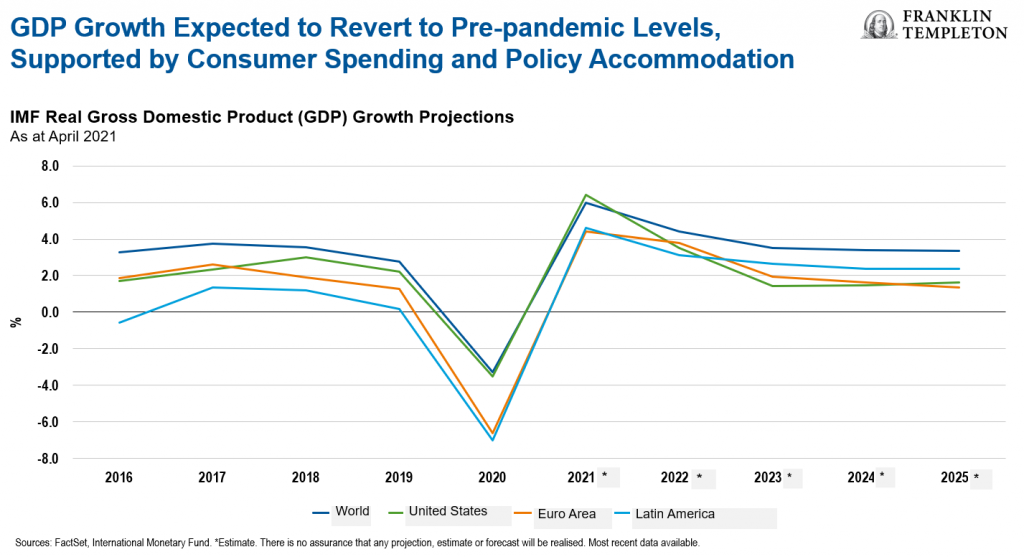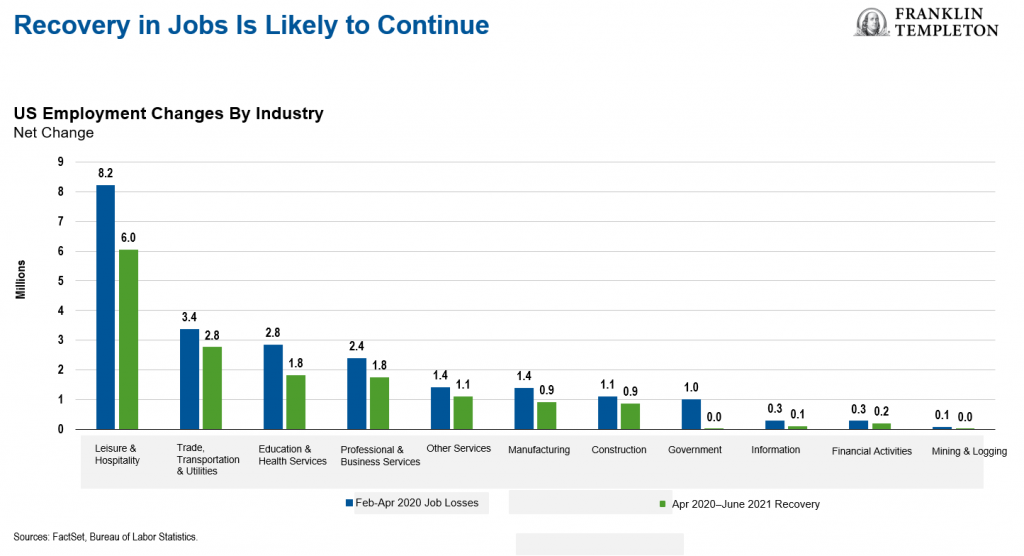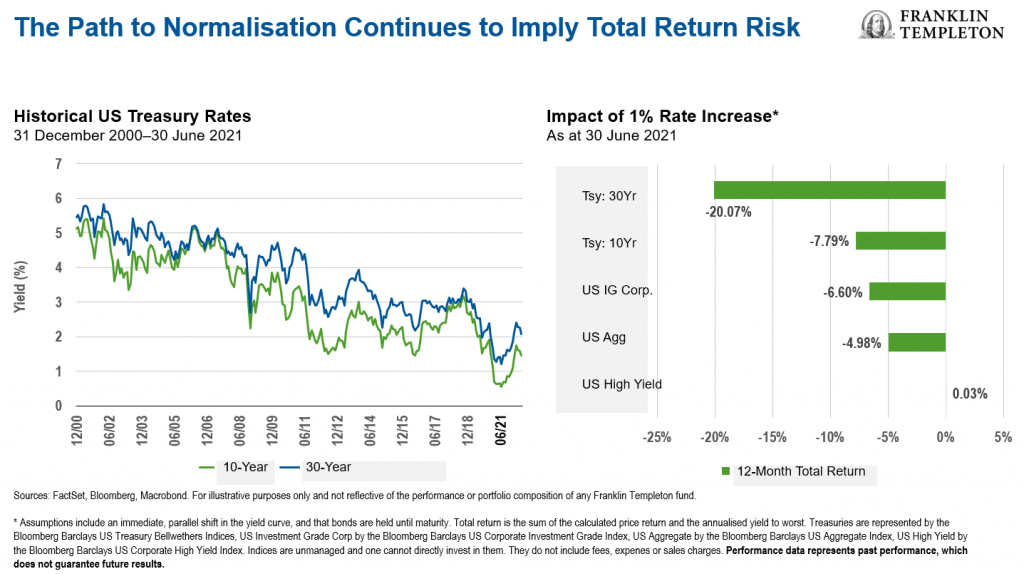by Edward D. Perks, CFA, Franklin Templeton Investments
Amid the reopening of economies and recovery from the pandemic, we see some robust shifts in economic activity. The rebound in consumer participation is an important part of the growth story we’ve seen in 2021, with accommodative monetary and fiscal policies also playing an important role. Going forward, we see these forces continuing to drive growth—albeit with some moderation—as consumers are in a strong place to spend and policy accommodation seems likely to continue over the next 12 to 18 months.
Consumer Strength and Inflation
As lockdowns ended, we saw a lot of pent-up consumer demand unleashed. Policy accommodation—government programmes and monetary policy support—has helped consumers come through the pandemic in a fairly healthy position in terms of balance-sheet strength. Many have significant excess savings driving robust spending on a variety of goods and services. The labour market has also rebounded sharply. We continue to see real upside in terms of job growth and creation, as well as some nascent signs of wage gains, which are expected to be an important part of economic activity and growth as we move forward. The July US employment report reflected these dynamics, adding 943,000 non-farm payroll gains and a 0.4% month-over-month rise in hourly wages. While there are still some seven million jobs that are yet to return from pre-pandemic, we believe the recent trend in jobs recovery is likely to continue. While the Delta variant adds risks to the outlook, overall we see some healthy tailwinds for the US consumer.
Inflation is the other side of the coin, with messaging from the US Federal Reserve (Fed) referring to the “transitory” nature of recent elevated inflation prints. We are seeing price pressures related to economic reopening, but this is a very unique time historically. Economic activity essentially came to a halt with COVID-19-related shutdowns; restart of activity created supply chain bottlenecks and pockets of inflationary heat.
Nevertheless, there is a lot of focus on what exactly “transitory” means. While we are starting to see some signs of cooling in price increases in the United States—as reflected in the July Consumer Price Index data—we still have concerns that some inflationary pressures will potentially last longer. But how long can we observe “transitory” inflation before fears develop in the markets that it may be more persistent? This is an important consideration as it relates to one of the key pillars that’s driving economic activity—policy accommodation. The Fed is still buying Treasuries and mortgage-backed securities and has kept interest rates near zero. Longer-term, we do expect the Fed to move away from its highly accommodative position. But initially, any tapering could materialise in the form of reduced asset purchases, or the Fed could provide more clarity around when it intends to raise short-term interest rates. We will be watching the Fed and monetary policy globally in the second half of 2021 and as we enter 2022 to shape our views of the markets.
Opportunities and Risks in US Equities and Fixed Income
As we entered the pandemic period and economies were shuttered, there was tremendous divergence in performance within equity markets. Initially, we saw strong performance from a very narrow group of companies—the growth-oriented beneficiaries of the pandemic that included largely technology and e-commerce firms. At the same time, more cyclical segments of the market, for example, energy and financial sector companies, experienced a more challenging backdrop at the start of the pandemic. As we made our way through the pandemic and vaccines were developed and economies reopened, we saw the latter catching up and converging with the early winners. Today, as we look across equities, we see a more equitable landscape with a broad set of investment opportunities.
In terms of a general outlook for equities, companies have needed to grow into their recent valuations. We have seen this happen, especially with the strong second-quarter 2021 corporate earnings season. As we look forward into the next six to 18 months, we see these favourable tailwinds likely to continue.
As it relates to fixed income, we see a stark contrast to equities—while interest rates have increased after bottoming in August 2020, they are still at relatively low levels and prospects for attractive total return are therefore somewhat limited.
Hypothetically, if we were to see an instantaneous 100-basis point increase in interest rates across the curve, longer-duration Treasuries would likely bear the brunt of that shock. Moving to shorter-duration assets, and more importantly into credit spread sectors within fixed income, the outcome looks a bit more benign, but still represents a challenged backdrop for fixed income securities from the standpoint of total return expectations. That said, we do see pockets of opportunities amid favourable corporate fundamentals, particularly in high-yield corporate bonds.
Multi-Asset Income Approach
As we think about investing for income, we believe flexibility in asset allocation and rigorous security selection can be a benefit. We believe having the flexibility and being nimble in taking advantage of any dislocations that may occur in evolving markets is important, especially against the current backdrop of generally full valuations across many financial assets.
Given the current environment and the challenge of maintaining an attractive and consistent level of income in a multi-asset portfolio, again, we think flexibility is of utmost importance. As we progressed through the pandemic and experienced the bifurcations within financial markets, it was very important, in our view, to have a broad scope in looking for opportunities, to be able to tactically shift the portfolio and to be targeted in pursuing the income goal.
Looking forward, we will continue to pay very close attention to policy changes, growth trends and inflationary pressures and what kind of dynamics they can create within the markets, while continuing to look for opportunities that deliver attractive income as well as a strong profile in terms of total returns relative to risk.
What Are the Risks?
All investments involve risks, including possible loss of principal. The value of investments can go down as well as up, and investors may not get back the full amount invested. Stock prices fluctuate, sometimes rapidly and dramatically, due to factors affecting individual companies, particular industries or sectors, or general market conditions. Bond prices generally move in the opposite direction of interest rates. Investments in lower-rated bonds include higher risk of default and loss of principal. Thus, as prices of bonds in an investment portfolio adjust to a rise in interest rates, the value of the portfolio may decline. Changes in the credit rating of a bond, or in the credit rating or financial strength of a bond’s issuer, insurer or guarantor, may affect the bond’s value. High yields reflect the higher credit risk associated with these lower-rated securities and, in some cases, the lower market prices for these instruments. Convertible securities are subject to the risks of stocks when the underlying stock price is high relative to the conversion price (because more of the security’s value resides in the conversion feature) and debt securities when the underlying stock price is low relative to the conversion price (because the conversion feature is less valuable). A convertible security is not as sensitive to interest rate changes as a similar non-convertible debt security, and generally has less potential for gain or loss than the underlying stock. Actively managed strategies could experience losses if the investment manager’s judgment about markets, interest rates or the attractiveness, relative values, liquidity or potential appreciation of particular investments made for a portfolio, proves to be incorrect. There can be no guarantee that an investment manager’s investment techniques or decisions will produce the desired results.
Important Legal Information
This material is intended to be of general interest only and should not be construed as individual investment advice or a recommendation or solicitation to buy, sell or hold any security or to adopt any investment strategy. It does not constitute legal or tax advice. This material may not be reproduced, distributed or published without prior written permission from Franklin Templeton.
The views expressed are those of the investment manager and the comments, opinions and analyses are rendered as at publication date and may change without notice. The underlying assumptions and these views are subject to change based on market and other conditions and may differ from other portfolio managers or of the firm as a whole. The information provided in this material is not intended as a complete analysis of every material fact regarding any country, region or market. There is no assurance that any prediction, projection or forecast on the economy, stock market, bond market or the economic trends of the markets will be realised. The value of investments and the income from them can go down as well as up and you may not get back the full amount that you invested. Past performance is not necessarily indicative nor a guarantee of future performance. All investments involve risks, including possible loss of principal.
Any research and analysis contained in this material has been procured by Franklin Templeton for its own purposes and may be acted upon in that connection and, as such, is provided to you incidentally. Data from third party sources may have been used in the preparation of this material and Franklin Templeton (“FT”) has not independently verified, validated or audited such data. Although information has been obtained from sources that Franklin Templeton believes to be reliable, no guarantee can be given as to its accuracy and such information may be incomplete or condensed and may be subject to change at any time without notice. The mention of any individual securities should neither constitute nor be construed as a recommendation to purchase, hold or sell any securities, and the information provided regarding such individual securities (if any) is not a sufficient basis upon which to make an investment decision. FT accepts no liability whatsoever for any loss arising from use of this information and reliance upon the comments, opinions and analyses in the material is at the sole discretion of the user.
Products, services and information may not be available in all jurisdictions and are offered outside the U.S. by other FT affiliates and/or their distributors as local laws and regulation permits. Please consult your own financial professional or Franklin Templeton institutional contact for further information on availability of products and services in your jurisdiction.
Issued in the U.S. by Franklin Distributors, LLC, One Franklin Parkway, San Mateo, California 94403-1906, (800) DIAL BEN/342-5236, franklintempleton.com – Franklin Distributors, LLC, member FINRA/SIPC, is the principal distributor of Franklin Templeton U.S. registered products, which are not FDIC insured; may lose value; and are not bank guaranteed and are available only in jurisdictions where an offer or solicitation of such products is permitted under applicable laws and regulation.
This post was first published at the official blog of Franklin Templeton Investments.


















